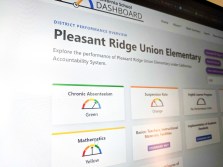Schools find a classroom translation tool has benefits for reaching parents, too
Usually when educators talk about language barriers in schools, the conversation focuses on students and teachers. But almost as crucial is the ability of teachers to talk with students’ parents or guardians when English is not the caregiver’s native tongue.
Although translation software is nearly ubiquitous these days, and every major U.S. tech company makes it available in one way or another, not all of them have focused on the education market. Microsoft appears to be ahead with Microsoft Translator, which is included in its Learning Tools suite that is part of Office 365.
Ease of use is one of the reasons, said Christopher Lee, chief learning officer for the International Association of Accessibility Professionals, an international membership organization focused on accessibility. “Microsoft has really focused on education, and recently, particularly on putting their tools in locations in its [software] where teachers can see them and access them,” Lee said.
Systems like Onslow County Schools in eastern North Carolina are finding that whatever works in the classroom also works when parents are the audience, too. The county has a lot of farmland maintained by migrant workers with children, said Denise Collins, the digital learning and teaching facilitator for the district.
One school, the Thompson Early Childhood Center, holds a transition meeting for parents of preschoolers moving on to kindergarten. Collins said representatives from “at least 20” resource offices — the school, mental health and other outside agencies — are on hand, all in one big room. In previous years, there would be a translator for the Spanish-speaking parents, but “it would be a little confusing, because two speakers were going on at the same time,” she said.
This year “we did the same thing, all the presentations one after another, but the Spanish-speaking parents went to another room with a Skype session, a split screen and Microsoft Translator going on at the same time. The parents were very impressed,” she said. Skype showed the presentations going on in the main room on one half of the screen, while on the other half, the Spanish translation appeared, like closed captioning.
“The thing that impressed them [was] they realized there was a resource they could use to speak with the school,” she said.
By downloading Translator to their phones or accessing it on their laptops, the parents can now have direct conversations with their child’s teacher or school official. They can open the Translator app and speak into their device, which translates it into English for the teacher or administrator. That also means they can use it to communicate in the broader community, instead of relying on the child to translate, which otherwise is what often happens.
Eric Ferguson, director of instructional technology for the Bellevue School District, located just outside of Seattle, said his district faced a similar challenge. “Our demographics are changing quite a bit — 37 percent of our students speak a first language other than English.”
Almost 40 percent of Bellevue’s students are Asian, he said, which means there are many more languages that require translation, such as Mandarin, Japanese, Korean, Vietnamese and Indonesian.
“Last spring we kind of got introduced to how we could use these tools to talk to parents. One of the really cool things … we’ve been using the Translator app for is to help our principals talk to some of our community groups,” Ferguson said. “We’ve started having sessions where we tell parents to bring their cell phones and they download the app.”
When the principal displays a list of school events or standardized tests, each parent is able to see it in the app in their native language, he added.
Encouraging schools to broaden their use of Translator is “a scenario we’ve been doing with schools and parents,” Mike Tholfsen, principal product manager for Microsoft Education, told EdScoop. “Even simple things like when a new family is coming in for the first day, [the] administrator can hand them a sheet in Vietnamese giving them instructions how to download Translator. Outcomes improve, grades improve, and teachers and principals communicate easily with parents” about their children’s progress.”




